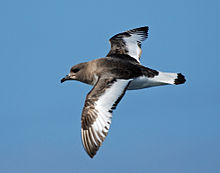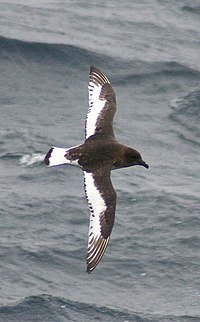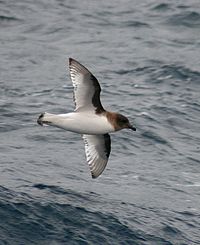Antarctic petrel
| Antarctic petrel | |
|---|---|

| |
| Scientific classification | |
| Kingdom: | Animalia |
| Phylum: | Chordata |
| Class: | Aves |
| Order: | Procellariiformes |
| Family: | Procellariidae |
| Genus: | Thalassoica Reichenbach, 1853 |
| Species: | T. antarctica
|
| Binomial name | |
| Thalassoica antarctica (J. F. Gmelin 1789)[2]
| |

| |
The Antarctic petrel (Thalassoica antarctica) is a boldly marked dark brown and white petrel, found in Antarctica, most commonly in the Ross and Weddell Seas. They eat Antarctic krill, fish, and small squid. They feed while swimming but can dive from both the surface and the air.[3]
Taxonomy and systematics[]
The Antarctic petrel is the only known species of the genus Thalassoica.[1] It is in the family Procellariidae of the order Procellariiformes.[1][4] This petrel along with the snow petrel, the Cape petrel, both giant petrels, and the two species in the Fulmarus family, are considered to be a different subclade from the other Procellariidae members.[5] They share certain identifying features. First, they have nasal passages that attach to the upper bill called naricorns. Although the nostrils on the petrels are on the top of the upper bill. The bills of Procellariiformes are also unique in that they are split into between seven and nine horny plates. On petrels, one of these plates forms the hooked portion of the upper bill. They produce a stomach oil made up of wax esters and triglycerides that is stored in the proventriculus. This can be sprayed out of their mouths as a defence against predators and as an energy rich food source for chicks and for the adults during their long flights.[6] Finally, they also have a salt gland that is situated above the nasal passage and helps desalinate their bodies, due to the high amount of ocean water that they imbibe. It excretes a high saline solution from their nose.[7]
Etymology[]
The word petrel is derived from St. Peter and the story of his walking on water. This is in reference to the petrel's habit of appearing to run on the water to take off.[8]
Description[]


The adult Antarctic petrel has a brown head, sides, throat, and back.[9][10] Their bill is black and their feet are yellow. Their underparts are white and their tail and secondaries on their wings are white with brown tips.[9][10] They are medium-sized relative to other petrels with a wingspan of 100–110 cm (39–43 in),[10] a length of 43 cm (17 in),[11] and an average weight of 675 g (23.8 oz).[10][11]
Their generation length is 15 years.[1]
The petrel's diet is mainly small fish, squid, and krill.[1][10] They use the surface-seizing or plunge-diving methods to obtain food.[11] They can dive up to 1.5 m (4 ft 11 in).[11]
Mating[]
The Antarctic petrel breeding period is during October-November.[10][12] Each pair lays a single egg, which incubates for 45-48 days after which there is a 42-47 day nestling period.[10][12] Both members of the pair incubate the egg, 4% of pairs are female-female.[12]
Eggs have a 70-90% hatching rate.[10] The two main causes of egg loss were predation by South polar skuas, and an egg rolling out of the nest and freezing.[10]
Distribution and habitat[]
The Antarctic petrel, as its name implies, lives and breeds in the Southern Ocean, and on the Antarctic islands.[13] They nest on snow-free cliffs and rock faces, on the coast or on offshore islands.[1] However, they have been found up to 250km inland.[1] Another common roosting spot is icebergs.[10] Breeding colonies during the October-November breeding period, can be as large as more than 200,000 pairs.[10]
They occasionally migrate to Australia or New Zealand in late winter.[10] Unfortunately, this tends to occur when they're caught in a bad storm.[11]
Status[]
This petrel has an estimated occurrence range of 77,500,000 km2 (29,922,917 sq mi) and between 10 and 20 million adult birds.[1] Due to its huge range and large numbers, it has been classified by the International Union for Conservation of Nature as a species of least concern.[1]
References[]
- ^ a b c d e f g h i BirdLife International (2018). "Antarctic Petrel - Thalassoica antarctica". IUCN Red List of Threatened Species. 2018. Retrieved 2 August 2021.
- ^ "Species Factsheet: Antarctic Petrel (Thalassoica antarctica)". BirdLife International. Archived from the original on 23 January 2021. Retrieved 25 October 2020.
- ^ ZipCode Zoo (16 Jul 2009). "Procellariinae (Subfamily)". BayScience Foundation. Archived from the original on 2012-06-09. Retrieved 20 Jul 2009.
- ^ Brands, Sheila (14 Aug 2008). "Systema Naturae 2000 / Classification - Genus Thalassoica-". Project: The Taxonomicon. Archived from the original on 5 November 2007. Retrieved 22 Feb 2009.
- ^ Tree of Life (27 Jun 2008). "Procellariidae. Shearwaters, Petrels". Tree of Life Web Project. Archived from the original on 15 February 2009. Retrieved 18 Mar 2009.
- ^ Double, M. C. (2003). "Procellariiformes (Tubenosed Seabirds)". In Hutchins, Michael; Jackson, Jerome A.; Bock, Walter J.; Olendorf, Donna (eds.). Grzimek's Animal Life Encyclopedia. 8, Birds I: Tinamous and Ratites to Hoatzins. Joseph E. Trumpey, Chief Scientific Illustrator (2nd ed.). Farmington Hills, MI: Gale Group. pp. 107–111. ISBN 0-7876-5784-0.
- ^ Ehrlich, Paul R.; Dobkin, David, S.; Wheye, Darryl (1988). The Birders Handbook (First ed.). New York, NY: Simon & Schuster. pp. 29–31. ISBN 0-671-65989-8.
- ^ Gotch, A. F. (1995) [1979]. "Albatrosses, Fulmars, Shearwaters, and Petrels". Latin Names Explained A Guide to the Scientific Classifications of Reptiles, Birds & Mammals. New York, NY: Facts on File. pp. 191–192. ISBN 0-8160-3377-3.
- ^ a b ZipCode Zoo (19 Jun 2009). "Thalassoica antarctica (Antarctic Fulmar)". BayScience Foundation. Archived from the original on 2012-06-09. Retrieved 20 Jul 2009.
- ^ a b c d e f g h i j k l "Antarctic petrel". www.antarctica.gov.au. Archived from the original on 2021-03-18. Retrieved 2021-08-02.
- ^ a b c d e Miskelly, C. M. (2013). "Antarctic petrel". New Zealand Birds Online. Archived from the original on 2021-03-03. Retrieved 2021-08-02.
- ^ a b c Lorentsen, Svein-Hȧkon; Amundsen, Trond; Anthonisen, Kristin; Lifjeld, Jan T. (2000). "Molecular Evidence for Extrapair Paternity and Female-Female Pairs in Antarctic Petrels". The Auk. 117 (4): 1042–1047. doi:10.2307/4089648. ISSN 0004-8038. Archived from the original on 2021-08-02. Retrieved 2021-08-02.
- ^ Clements, James (2007). The Clements Checklist of the Birds of the World (6th ed.). Ithaca, NY: Cornell University Press. ISBN 978-0-8014-4501-9.
External links[]
- IUCN Red List least concern species
- Procellariidae
- Birds of Antarctica
- Birds described in 1789
- Taxa named by Johann Friedrich Gmelin
